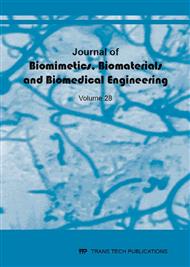[1]
M.C. Goiato, E. Freitas, D. dos Santos, R. de Medeiros, M. Sonego, Acrylic Resin Cytotoxicity for Denture Base-Literature Review, Adv. Clin. Exp. Med. 24 (2015) 679-686.
DOI: 10.17219/acem/33009
Google Scholar
[2]
J.C. Berger, C.F. Driscoll, E. Romberg, Q. Luo, G. Thompson, Surface roughness of denture base acrylic resins after processing and after polishing, J. Prosthodont. 15 (2006) 180-186.
DOI: 10.1111/j.1532-849x.2006.00098.x
Google Scholar
[3]
R. Gautam, R.D. Singh, V.P. Sharma, R. Siddhartha, P Chand, R. Kumar, Biocompatibility of polymethylmethacrylate resins used in dentistry, J. Biomed. Mater. Res. B Appl. Biomater. 100 (2012) 1444-1450.
DOI: 10.1002/jbm.b.32673
Google Scholar
[4]
J. John, S.A. Gangadhar, I. Shah, Flexural strength of heat-polymerized polymethyl methacrylate denture resin reinforced with glass, aramid, or nylon fibers, J. Prosthet. Dent. 86 (2001) 424-427.
DOI: 10.1067/mpr.2001.118564
Google Scholar
[5]
E. LaBarre, K. Tsiang, Advanced Removable Partial Dentures, J. Prosthodont. 15 (2006) 274-276.
DOI: 10.1111/j.1532-849x.2006.00118.x
Google Scholar
[6]
R. Bhola, S.M. Bhola, H. Liang, B. Mishra, Biocompatible Denture Polymers – A Review, Trends. Biomater. Artif. Organs. 23 (2010) 129-136.
Google Scholar
[7]
J.H. Jorge, E.T. Giampaolo, A.L. Machado, C.E. Vergani, Cytotoxicity of denture base acrylic resins: a literature review, J. Prosthet. Dent. 90 (2003) 190-193.
DOI: 10.1016/s0022-3913(03)00349-4
Google Scholar
[8]
L. Gölz, R.A. Simonis, J. Reichelt, H. Stark, M. Frentzen, J. -P. Allam, R. Probstmeier, J. Winter, D. Kraus, In vitro biocompatibility of ICON® and TEGDMA on human dental pulp stem cells, Dent. Mater. 32 (2016)1052-1064.
DOI: 10.1016/j.dental.2016.06.002
Google Scholar
[9]
L. Wang, P.H. Perlatti D'Alpino, L. Gonzaga Lopes, J.C. Pereira, Mechanical properties of dental restorative materials: relative contribution of laboratory tests, J. Appl. Oral. Sci. 11 (2003) 162-167.
DOI: 10.1590/s1678-77572003000300002
Google Scholar
[10]
C.A. de Souza Costa, J. Hebling, D.L.S. Scheffel, D.G.S. Soares, F.G. Basso, A. P. D. Ribeiro, Methods to evaluate and strategies to improve the biocompatibility of dental materials and operative techniques, Dent. Mater. 30 (2014) 769-784.
DOI: 10.1016/j.dental.2014.04.010
Google Scholar
[11]
W. Jin, Q. Hao, X. Peng, P. K. Chu, Enhanced corrosion resistance and biocompatibilty of PMMA-coated ZK60 magnesium alloy, Mater. Lett. 173 (2016) 178-181.
DOI: 10.1016/j.matlet.2016.03.071
Google Scholar
[12]
D. G . Gratton, S.A. Aquilino, Interim restorations, Dent. Clin. North. Am. 48 (2004) 487-497.
DOI: 10.1016/j.cden.2003.12.007
Google Scholar
[13]
R. Gautam, R.D. Singh, V.P. Sharma, R. Siddhartha, P. Chand, R. Kumar, Biocompatibility of polymethylmethacrylate resins used in dentistry, J. Biomed. Mater. Res. B. 100B (2012) 1444-1450.
DOI: 10.1002/jbm.b.32673
Google Scholar
[14]
K. Moharamzadeh, I. M. Brook, R. Van Noort, Biocompatibility of Resin-based Dental Materials, Materials. 2 (2009) 514-548.
DOI: 10.3390/ma2020514
Google Scholar
[15]
L.J. Rickman, P. Padipatvuthikul, J.D. Satterthwaite, Contemporary denture base resins: Part 1, Dent. Update. 39 (2012) 25-28.
DOI: 10.12968/denu.2012.39.1.25
Google Scholar
[16]
Y. Ucar, T. Akova, I. Aysan, Mechanical properties of polyamide versus different PMMA denture base materials, J. Prosthodont. 21 (2012) 173-176.
DOI: 10.1111/j.1532-849x.2011.00804.x
Google Scholar
[17]
T.W. Chow, Y.Y. Cheng, N.H. Ladizesky, Polyethylene fibre reinforced poly(methylmethacrylate)-water sorption and dimensional changes during immersion, J. Dent. 21 (1993) 367-372.
DOI: 10.1016/0300-5712(93)90014-h
Google Scholar
[18]
G. Gonçalves, M.T. Portolés, C. Ramírez-Santillán, M. Vallet-Regí, A.P. Serro, J. Grácio, P.A. Marques. Evaluation of the in vitro biocompatibility of PMMA/high-load HA/carbon nanostructures bone cement formulations, J. Mater. Sci. Mater. Med. 24 (2013).
DOI: 10.1007/s10856-013-5030-2
Google Scholar
[19]
F. Baino, S. Perero, S. Ferraris, M. Miola, C. Balagna, E. Verné, C. Vitale-Brovarone, A. Coggiola, D. Dolcino, M. Ferraris, Biomaterials for orbital implants and ocular prostheses: overview and future prospects, Acta. Biomater. 10 (2014).
DOI: 10.1016/j.actbio.2013.12.014
Google Scholar
[20]
C.A. de Souza Costa, H.M. Teixeira, A.B. Lopes do Nascimento, J. Hebling, Biocompatibility of resin-based dental materials applied as liners in deep cavities prepared in human teeth, J. Biomed. Mater. Res. B Appl. Biomater. 81(2007) 175-184.
DOI: 10.1002/jbm.b.30651
Google Scholar
[21]
J.H. Jorge, E.T. Giampaolo, C.E. Vergani, A.L. Machado, A.C. Pavarina, I.Z. Carlos, Biocompatibility of denture base acrylic resins evaluated in culture of L929 cells. Effect of polymerisation cycle and post-polymerisation treatments, Gerodontology. 24 (2007).
DOI: 10.1111/j.1741-2358.2007.00146.x
Google Scholar
[22]
P. Thevenot, W. Hu, L. Tang, Surface chemistry influences implant biocompatibility, Curr. Top. Med. Chem. 8 (2008) 270-280.
DOI: 10.2174/156802608783790901
Google Scholar


